| 1 | Only sighted if it wants to be |
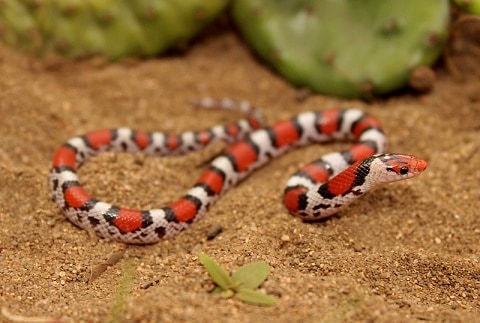
In the eastern US, there’s a snake which is extremely colourful, with patterns like an ancient totem pole, but still manages to be elusive and rarely seen by even the most dedicated reptile enthusiasts. This species is the scarlet snake, also known as Cemophora coccinea. This is a non-venomous snake which poses no threat to humans, and kills whatever prey it has by constriction. It measures just 36-66cm in adulthood, and has a thin body to top it off.
The colour is the most striking feature of this snake. Its base of scales is a neon red, but its body is wrapped with white stripes. Each of these stripes is bordered by black lines, so that the red markings never touch the white. The head is also red, and the patterns extend right to the tail.
Meanwhile, the belly is plain white or yellow, and occasionally pink. The white stripes are sometimes yellow, but the black borders are always firmly in place. The scarlet snake’s scales have a shine as well, as though they’ve been scrubbed hard with polish.
| 2 | Eats turtle eggs |
The scarlet snake isn’t mega-specific about its diet, as rodents, amphibians and lizards are all acceptable. That said, it definitely shows a preference towards lizards, and within the reptile-eating snake club, it’s well known for its egg-burgling habits. Scarlet snakes can swallow the smallest eggs whole, and with larger eggs they can crack open the shells and extract the contents.
In June 2011, scientists studying snakes on St Catherine’s Island on Georgia spotted two scarlet snakes slithering into underground egg chambers. This snake reconnaissance took place on a sandy beach, and the hunted species was the loggerhead sea turtle. According to the scientists, the snake was entering the tunnel “in a manner consistent with predatory behaviour“. 5 years later, scientists spotted a 44cm long scarlet snake slithering into another turtle chamber, this time on Jekyll island at 6:33am, before making further sightings on Catherine island in June 2017. The scarlet snake eats just as many eggs in captivity as well.
| 3 | Shell-piercing fangs |
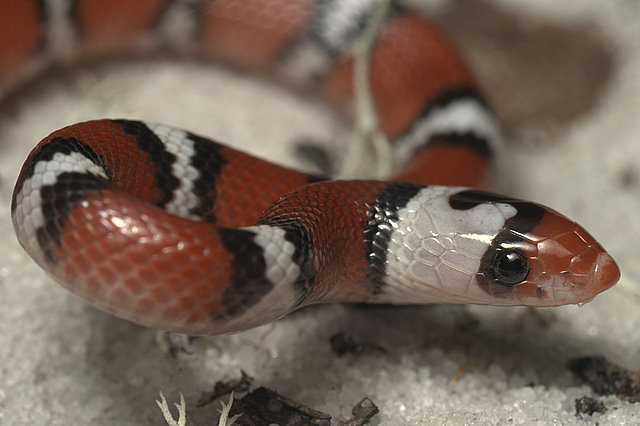
Biologists have also observed the snake’s patented egg-eating manoeuvre, despite being quite a mysterious snake generally. The scarlet snake begins by extending its mouth over the entire egg, with its sharp teeth piercing the egg shell.
Secondly, the snake wraps its entire body around the egg, and squeezes hard with its teeth still inside. This pressure forces the egg’s contents into the snake’s mouth, releasing the delicious golden yolk in a flood and leaving the shell mostly empty.
This dietary quirk leads to another special feature: unusually sharp front teeth. The species has no venom to deliver, but the scarlet snake’s front teeth are brutal and disproportionate to its short body. This is vital for hacking through thousands of tough egg shells over the course of its life. This is a reverse of the pygmy rattlesnake, which does possess venom, yet has extremely short fangs, once estimated at just 0.5cm.
| 4 | Realm of the scarlet snake |
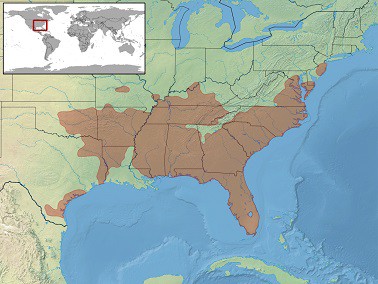
The scarlet snake mainly lives in the eastern USA, with none found in western states like California, Arizona, or Nevada. The most remote point is southeast Texas, just north of the Mexican border, and there’s also two isolated pockets in central Missouri and New Jersey.
The scarlet snake is moderately fussy about its habitat. You won’t find them in bustling cities or high mountains. The scarlet snake likes moderately sparse forests (but not dark, thick forests) with dense undergrowth, specifically coniferous forests and damp hardwood forests. In Florida, they also inhabit dry prairies and sparse flatwoods. This isn’t a snake which sneaks into people’s gardens like the garter snake, but you can sometimes find them in open fields adjacent to their habitats. If you’re lucky, you can spot them crossing rural roads as well.
The uniting feature is that scarlet snakes love dry, sandy soils with a high drainage rate, with all the looseness they need for burrowing. They can sometimes be found on beaches as well, particularly in their island enclaves, like St Catherine’s Island or Jekyll Island in Georgia.
| 5 | Hunted by spiders 20 times smaller |
From 2008 to 2021, a series of studies shed light on a constant David and Goliath battle happening in the animal kingdom. It turned out that snakes are regularly hunted by 11 different families of spiders, including spiders 10-30 times smaller than their own size.
This discovery came from 319 observations around the world, which included scientific studies but also simple camera images and amateur youtube videos. Two of the clearest observations happened to come from scarlet snakes, with one taking place on a front porch in Gulf Breeze, Florida. The scarlet snake had slithered into the thick web of a black widow spider, which soon took notice, and sprayed the only slightly stuck snake with an extra helping of web. This sealed its fate completely, and the spider’s next move was to envenomate the scarlet snake and wait for its death.
Instead of biting off massive chunks, the study revealed how spiders spray their caught snakes with enzymes. This converts their flesh into a soft soup which they can easily suck down. Scarlet snakes measure 50cm, but the biggest catch of all was a 1 metre green snake, hunted by a golden silk orb-weaver in Florida.
| 6 | Part of the nursery rhyme club |
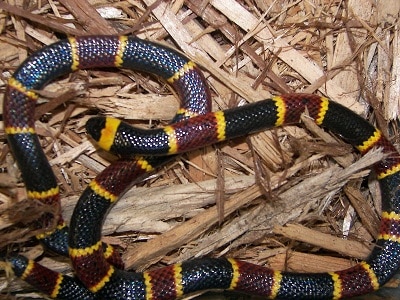
It’s believed that the scarlet snake adopted its bright patterns to mimic the deadly venomous coral snake, which also lives in Florida. What it didn’t expect was for a nursery rhyme to pop up in its honour. There’s several variations, but the most common version is “Red touches yellow, kills a fellow. Red touches black, friend of Jack”. A variation used for the scarlet snake is “red touches black, venom lack”, and another is “Yellow brushes red, snake gets fed. Red brushes black, snake gets no snack”. These snake safety rhymes have been passed down for generation after generation, from father to son, from mother to daughter.
The truth is in the rhyme: the scarlet snake always has a black border between the white and red areas. Indeed, the white never touches the red, whereas with the coral snake, there are no black borders. The old wisdom was correct after all. They might be simple, but some believe that these catchy rhymes have prevented way more snake bite deaths than any bland information sheet from the local government.
That said, the deadly South American coral snake does have red bands touching black. Stick to this trick in the US where it originated.
| 7 | Very hard to find |
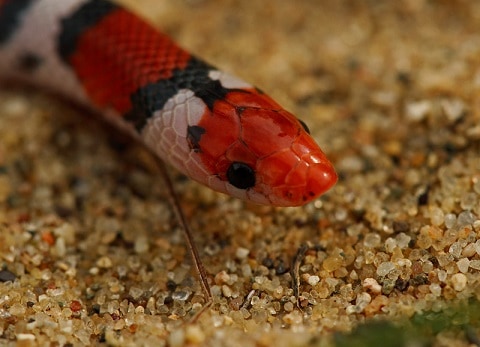
There’s a consensus among reptile enthusiasts that the scarlet snake is one of the hardest to track down. One forum poster mentioned how 10 of his friends had only made 10 observations in a combined 150 years of reptile-hunting. They’re sometimes spotted as roadkill, but reptile enthusiasts report that driving around backcountry roads is so ineffective that it’s effectively pointless.
The only way to find them is to identify local lizard hotspots, where its tasty egg meals will be in abundance. The ultimate time to arrive is during temperatures of 70 degrees fahrenheight, and at night. The ultimate strategy is to repeatedly overturn medium sized rocks as you walk.
In New Jersey, this is listed as a “threatened” species due to habitat loss, with its hardwood forests becoming increasingly fragmented. In Howard Country, Maryland, one reptile lover finally found a scarlet snake, phoned up the NPR, and was pleasantly surprised when the wildlife official arrived on the scene within 45 minutes. The scarlet snake had last been seen in the area in 1933, and the old record was reconfirmed.
| 8 | Digs its own burrows |
The scarlet snake is so secretive that nobody is even sure whether they’re endangered or not. They’re a nocturnal species and spend a large portion of their time underground, even when they’re not scouring tunnels for egg chambers.
Most snakes rely on premade tunnels to lurk in. These can be rodent burrows, shelters beneath rocks, or even the narrow channels of decaying tree roots. The scarlet snake is different, as its pointed snout allows it to dig its own burrows. That’s why loose soils are so important for them, as it gives them a vast playground to build a home wherever they want.
Above ground, they’re still likely to be found in shelter, such as beneath logs, leaf litter, or trash cans and lids in certain spots. They’re generally found beneath coarse woody debris (CWD), a technical term meaning leaves and rotting branches combined together over many months into a single foresty mixture. It’s extremely rare to see the scarlet snake above ground during the day.
| 9 | Ice age division |
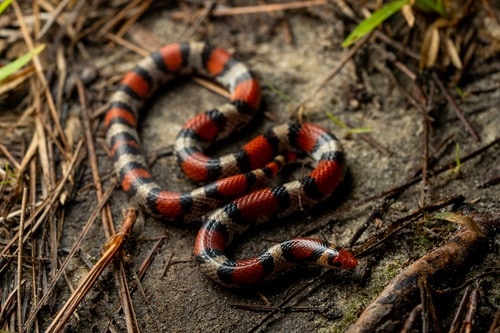
Originally it was believed that this snake had 3 subspecies, but today, only two remain. These are the Florida scarlet snake (Cemophora coccinea coccinea), which only lives in Florida as far north as Marion county, and the northern scarlet snake (c. coccinea copei), which occupies everywhere else. The differences are extremely subtle and mostly down to the number of scales.
The third, lost subspecies is the Texas scarlet snake. It vanished in 2012, when genetic testing proved it to be its own species altogether. The story goes back to the Pleistocene epoch, when the ancestor of the two scarlet snakes was forced by advancing ice sheets to flee southwards. The modern day scarlet snake took refuge in humid Florida, while another group bolted for southern Texas.
Separated by towering glaciers, the species diverged over time, with Cemophora lineri becoming larger and having slightly less extensive black marks. Scientists put the divergence at 4.86 to 1.37MYA. When the glaciers finally melted, the Florida scarlet snake began to venture north cautiously, and these new adventurers ultimately morphed into the second, northern subspecies. The Texas version moved further north within Texas, but not as far; even today, the range of Cemophora lineri doesn’t overlap with the main scarlet snake.
| 10 | Much to learn we still have |
Despite its brutal fangs, the scarlet snake somehow lacks the instincts for biting people. Its priority seems to be protecting its brain, as it usually tucks it heads into its tightly wrapped coils while in the palm of someone’s hand. They simultaneously raise their tail high into the air, most likely to distract from the head. They don’t use the play-dead manoeuvre of grass snakes, but they do release a foul smelling musky odour.
As a secretive snake, there are several gaps in the record with this species. We don’t know their swimming capabilities, and we don’t know their top speed, although some believe that they’re fairly fast. We do know that mother scarlet snakes lay up to 13 eggs, and abandon the young immediately after birth, unlike some rattlesnakes.
The original range was 2-9 eggs, a relatively small number, but in May 2013, a researcher observed a scarlet snake laying 13 eggs in Hillsborough County, Florida. These eggs were shorter than usual, but also wider. The snake was also freakishly long, measuring 75cm, well beyond the standard upper limit of 66cm.